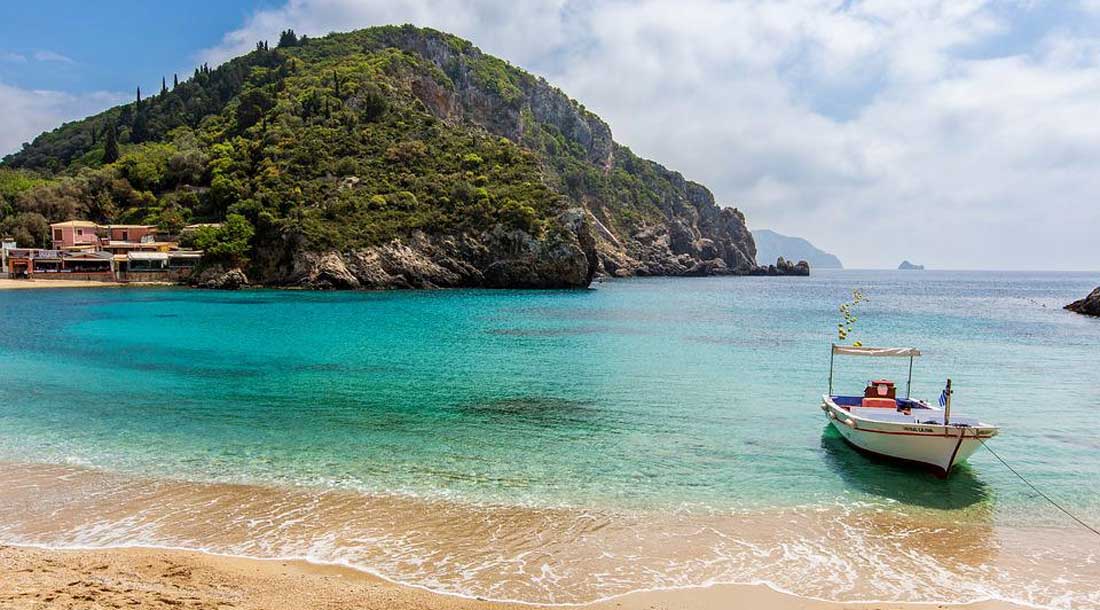The most popular beaches of Corfu
Corfu boasts some of the best beaches of all the Greek islands and the most popular seaside resorts are chockfull of every conceivable watersport, air and land-based activity.
You can bungee jump, parasail, scuba dive.even indulge in a spot of nude cliff jumping! The busiest beaches are flanked by video and music bars, fast food joints and souvenir shops.
But despite being one of the most popular holiday destinations in Greece, Corfu can still offer secluded beaches a world away from the mid-summer mayhem of the top tourist spots.
The coastal strip in the north east of the island, between Dasia and Pyrgi, has surrendered itself completely to the demands of the package holiday industry. The beaches here are awash with bars, discos, watersports and other entertainment facilities.
Ipsos, two kilometres north of Dasia, is home to Waterhoppers Diving Club, one of the island’s main diving centres which offers both beginners’ courses and wreck, night and deep dives for experienced divers.
Barbati Beach, four kilometres north of Ipsos, is one of the best on this stretch of coastline and is a popular choice among families.
Further north you’ll come to the small pebble coves of Nisaki and Agni before reaching the picturesque village of Kalami, famed as the one-time home of writers Gerald and Lawrence Durrell. Tavernas line the sand and pebble beach which looks across the bay to the hills of Albania. Durrell fans will want to have lunch in the waterfront White House, once the brothers’ home and now a popular taverna.
Kassiopi, at the north eastern tip of the island, is one of the busiest resort areas – once a quiet and pretty fishing village, now a fully-fledged party place with five beaches, watersports galore and all-night discos manned by international DJs.
Almyros, on the north coast is a lovely, long and undeveloped beach unlike its busy neighbour Sidhari in the north west corner of the island. If you want to secure the love of your life, swim together through the famous Canal d’Amour (love tunnel) of Sidhari to guarantee your future together.
Agios Stefanos, 15 minutes drive south west of Sidhari, is a relatively quiet family resort with a long sandy beach backed by towering sandstone cliffs. From here you can take a boat trip over to the three lonely Diapondia islands, scattered 20 kilometres off the north west coast.
The biggest resort on the west coast is stunningly beautiful Paleokastritsa where a series of sand and pebble coves provide safe swimming against a green and mountainous backdrop.
This is one of the island’s prime diving locations and you can take a water taxi to visit the nearby grottoes.
Further south west along the coast lies magnificent Myrtiotissa, a tree-fringed sweep of golden sand described by Lawrence Durrell as “perhaps the loveliest beach in the world”.
The western edge of the Korissia Lagoon is flanked by sand dunes and lonely beaches which are a far cry from frantic Kavos in the south east corner of the island. Like bustling Benitses, south of Corfu Town, Kavos is frequented by the “booze and beach” brigade whose quest for round-the-clock seaside entertainment ends at these two raucous resorts
That’s not all: the island is also home to many beaches with varying landscapes and atmosphere. If you want to discover a little more about the most beautiful beaches not to be missed when you come, continue reading this article.
Kontokali beach
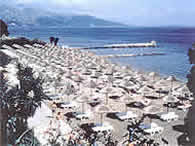
But just before Gouvia, and almost merged into it, is the busy resort of Kontokali which defies its cement-paved surroundings to offer some subdued nightlife, several good tavernas and and fine views over the Bay of Gouvia.
Kontokali village has several shops and restaurants, the remains of a castle. The narrow streets end up at a couple of sand and pebble beaches, if you can see either for the grids of sunbeds.
It’s shallow water between a couple of groins and a watersports area is cordoned off to prevent accidents. Showers are available and you can even rent beach towels.
The beach to the north of Kontokali is smaller and gets greater use from the locals. Further north along the coast are the ruins of an ancient Venetian shipyard.
Cape Komeno
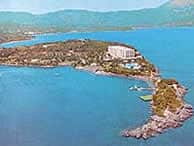
Visitors looking for a base to explore the north-east of the island will find Komeno well sited for the task. The promonotory is little more than scrub and rock but there are splendid views over the bay to Corfu Town to the yacht marina in Gouvia to the south, whilst to the north is the Gulf of Dassia and the holiday resorts of Dassia and Ipsos.
The hotel complex has sea on both sides and there are many small inlets and bays for sunbathing. Most beach coves are shingle and stone but come with changing cabins and showers courtesy of the hotel.
Dassia beach
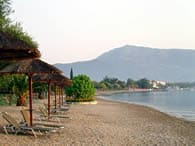
A network of footpaths lead down to Dassia beach – a long strip of stone and sharp shingle with just a little sand, about 200 metres long and 30 meters deep with the shallow waters backed by dramatic pine and olive topped cliffs.
A long cement path runs down the back of the beach but there are no showers or toilets. At the southern end is a small bay with a ruined Venetian boatyard, but it’s a bit of a scramble to get there.
Dassia resort proper has a wide range of restaurants and bars, although it’s mostly uninspired tourist fare. Many shops are given over to selling souvenir trinkets but the locals are known throughout Corfu for their friendliness.
Surprisingly, Dassia has little night-life despite the high tourist numbers, so visitors often hop to nearby Ipsos for clubbing. It is about 15 minutes on foot with fine views all the way.
Ipsos beach
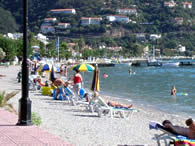
The beach is a narrow, long strip of shingle and sand backed by a very busy road. The best bit is south near the harbour; it’s quieter there, though not much. Another small harbour lies to the north.
There are watersports galore with jetties every 50 yards or so. Showers and toilets are available and there is lighting along the main Ipsos road where families must run a gauntlet of traffic to reach the tavernas and cafes away from the beach.
A downmarket atmosphere pervades Ipsos, but this is not Ibiza or Faliraki – the clubs generally close around 4am. Tavernas sell basic, low-priced meals and bars boast giant TVs, all-day English breakfast, pool tables and gaming machines.
Select Ipsos ain’t and if you want more than a tan and a hangover you may be disappointed. If it’s cheap, cheerful and noisy you’re after then Ipsos could be just the ticket.
The neighbouring resort at Pyrgi is just an extension of Ipsos; a little less hectic, a bit cheaper and Greek food on the menu now and then. What a contrast in the hills where the lovely village of Agios Markos is a step back in time and a step up in quality.
Barbati
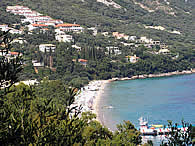
Barbati beach is relatively quiet until boat loads of day trippers arrive from Kerkyra and Ipsos. There are showers and toilets at the back of the beach alongside cantinas and beach bars.
Three large complexes of apartments are arranged in ranks up the hill and the network of roads that feeds them provides plenty of parking.
The water is shallow on the east-facing beach but it does drop off steeply a little way out. Rocks at both ends provide interest and there are sunbeds and watersports.
Barbati village is set on the steep hillside between the main road and the beach with terrific views over the bay and plenty of shops.
The night-life is low key but Corfu Town is only 20 minutes away on the daily bus. There is no taxi rank here but locals are happy to phone for you.
Nissaki
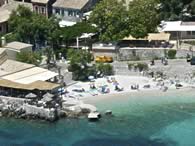
Nissaki is Greek for ‘islet’ and so it once was before quarrying joined the islet to to the shore and created the beach.
Don’t confuse this with nearby Krouzari beach, which is much bigger and dominated by the ineptly named Nissaki Beach Hotel.
Nissaki is ideal for those who like it quiet, enjoy lovely views and want little more than a taverna and sunbed.
The resort is noted for its excellent tavernas, three close to the beach and two in the village. There is also a cafe and a minimarket.
The neighbouring beach at Krouzari is a long strip of steep sloping shingle. There are showers, changing rooms and toilets and tees behind provide natural shade.
There are the usual sunbeds and watersports you expect on a developed hotel beach.
Kaminaki
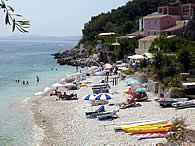
Sunbeds are for hire and the beach has a single shower and but no toilets. Visitors can use the beach taverna and there is another taverna on the cliffs above.
A single mini market provides basic village shopping and it’s a steep drive down the hill to Kaminaki beach where there is limited parking.
Kaminaki is only a short coastal walk to the huge Nissaki Beach Hotel, so the beach tends to get busy later in the day but this is still a place to chill and relax.
Agni beach
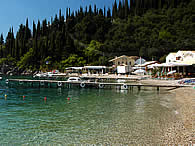
It’s a small bay of pebbles with the odd patch of sand. Three tavernas open in the summer, all with views across to Albania.
Jetties have been built to accommodate the boats that regularly pull in here. Agni beach shelves deeply and the sharp underwater rocks make this an unsuitable beach for children.
Apart from the tavernas the resort has no facilities. Agni has a beautiful and peaceful setting and a deeply relaxed atmosphere.
Kalami
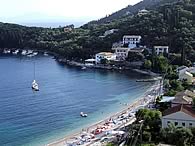
The resort has strong literary connection with the Durrells – Lawrence and Gerald – who had a home here called the White House.
Once a quiet retreat, Kalami is now home to one of the biggest self-catering complexes on Corfu. It sprawls up the hillside, although expertly planted wisteria hides most of it.
The beach is stone and pebble and Albania sits just two kilometres offshore. On the headland towards Kouloura are sheltered coves with flat rocks for sunbathing, but they can only be reached by boat.
Kalami village has mini-markets, shops and a couple of tavernas.
Kouloura beach
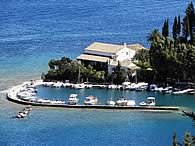
But Kouloura enjoys a beautiful setting that oozes peace and tranquillity. Rocky coves offer snorkelling and sunbathing.
Much visited by boats, the bay can get dirty with fuel in the summer and sea urchins are a problem on the rocks.
No watersports, no bars, no clubs, one taverna and the nearest shop is a 20 minute walk to Kalami – heaven on earth some will say.
Kerasia beach
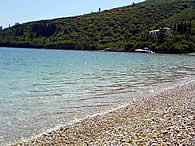
Surrounded by olive and pine the beach is flat and water shallow, although it dips sharply after a few metres.
Kerasia has a single beach taverna and a small shop but not much else, although sunbeds are for hire and there is plenty of parking.
Prince Charles is an occasional guest of the Rothschilds, who have a large estate nearby but you are unlikely find yourself sharing the beach with royalty
Agios Stefanos
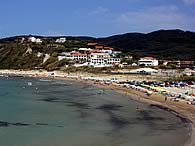
There are four tavernas on the beach and a couple more in the village where there is also a mini-market and a few gift shops.
An upmarket resort that has earned the nickname ‘Kensington-on-Sea’, the luxury villas that dot the surrounding hills come tagged with very exclusive prices.
A prime target for day-trip boats, Agios Stefanos can get busy quite quickly. Sunbeds line the beach but the the shingle drops very steeply into a deep sea, so it’s not great for children.
Neighbouring coves include the pretty Kerasia beach and horse riding is on offer at the nearby Emeritus Nature Reserve.
The narrow, winding road down to the beach is steep and difficult, not least because of the repeated urge to stop and take photos.
North coast beaches
The north has the best and the worst of the landscape. For 10km or so out of Corfu town the visitor is greeted by a dreary sprawl of hotels and apartments relieved only by occasional vegetation. Further north the highway peters out and the scene changes dramatically. An impressive rocky coastline is backed by the greenest of hills and a more typically Greek atmosphere in small pebble coves and dazzling turquoise waters. It is only in the larger resorts that Corfu slides back into tourist-driven tackiness.
Avlaki beach
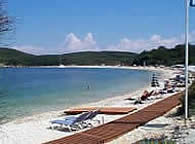
A popular spot for weekending Greeks, the narrow 800 metre-long beach is mostly shingle with sunbeds, boardwalks and a shallow sea for a few metres before dropping off sharply.
Avlaki is very quiet, but with more lively resorts are only a short walk away and visitors can always opt for a boat trip to Kerkyra.
There are canoes for hire and a sailing school, a couple of tavernas and a bar but no shops – the nearest is at Kassiopi.
A couple of small coves of rock and shingle lie beyond the headlands at either end of Avlaki beach.
Kassiopi
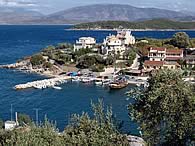
Kassiopi still finds room for traditional tavernas and regular visitors emphasize the relaxed friendliness of the locals.
The resort has a pretty waterfront but much of the village is thick with souvenir shops while a quartet of mini-markets meet the basic shopping needs.
Four beaches can be reached along footpaths around the headland but none are particularly good. The main Kassiopi beach is pebble and has showers and toilets.
The other beaches have no facilities and better beaches can be found south at Avlaki and Koyevinas – about 20 minutes drive.
Boats trips leave daily for Corfu Town and to other sands along the coast. Castle ruins overlook the harbour but there is little to see.
Agios Spiridon
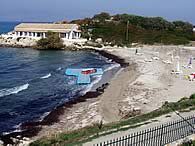
The sandy beach is set in a small bay with rocks to either side. A longer and better beach lies about 500 metres west.
The shoreline on both beaches is shallow with rock pools to add interest and with sunbeds, showers, toilets, changing rooms and a cantina that opens in the summer.
Agios Spiridon village has a couple of mini-markets, a tourist shop and three tavernas – all highly recommended. In a nearby nature reserve walkers will find plenty to admire on the local trails.
A nearby lagoon is home to the showy sea daffodil but don’t pick any, they now very rare in Greece.
Almyros beach
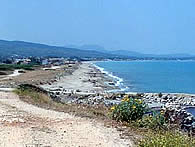
The western end of the seven-kilometre long sands is quiet with dunes and shallow water while the east has the hotels and restaurants, beach sports and windsurfing.
Pebbles are more marked in the centre where there is a sharp drop into the sea. In places the beach is wide but often there is just room for a single line of loungers.
Almyros is a good spot for visitors who like the combination of lively and quiet. Escape the crowds by walking west. There are good views across to the Albanian hills.
Acharavi
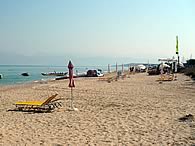
The beach is sand and pebble and shelves gently into the sea. It’s a clear favourite with families although stones lie underfoot so it’s wise to have footwear.
The beach may be a relief from the dishevelled mess that flanks the highway but the village does offer a wide range of facilities including doctors, bank, post office and mini-markets.
n the hills behind the village walkers can get on the Corfu Trail and other excellent walking paths lead up Mt Pantokrator.
There are the remains of Roman baths nearby. A good water park (Hydropolis) is 10 minutes walk and many Acharavi hotels offer free use of the pool.
Roda beach
Roda is a small, pretty, but essentially charmless village with a large number of bars, restaurants and small shops about three hour drive from Corfu Airport along twisting roads.
It looks like an English seaside town with karaoke and bingo on offer in scores of British-theme pubs, many run by ex-pats.
Access to Roda beach is down steps from the main road where there is limited parking. The beach is sandy with pebbles at the eastern end with shallow water that’s ideal for children.
A downmarket resort for years, Roda has made an effort to improve itself with some palm tree planting, seafront benches and regular daily beach cleaning.
A midnight restriction helps mitigate the nightly noise but the main Sidari road is very busy 24 hours-a-day.
Sidari beach
The big guns of the British package firms have been trained on Sidari for some years and the once pretty village square is now lost in a hectic maze of happy hour bars, Brit-style pubs and trinket shops.
Sidari has three beaches. The first and least popular is near the old fishing harbour to the east. The central beach is a long sweep of sand with a vast array of watersports. To the west is the famous Canal d’Amour area, where sandstone cliffs are eroded into spectacular formations and where the small sandy coves are as attractive as they are overcrowded.
The resort’s main street is narrow and busy and the restaurants and bars that fringe it offer a diet of bingo, TV football and chips. Sidari is much like a Greek Blackpool.
Sidari nightlife is cheap and cheerful too, and enlivened by endless karaoke. The Sidari area is notorious for mosquitoes so don’t forget the insect spray.
Peraloudes
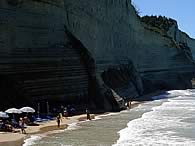
The main Peroulades beach is hardly that – just a narrow strip of sand below vertical cliffs that require a perilous descent down scores of winding cement steps.
The taverna above Peroulades beach offers stunning sunset views and lends the place its alternative name of Sunset Beach.
West coast beaches
From rocky cliffs to long sandy beaches, the west coast has more to offer those looking to get away from the crowds on Corfu. Although tourism has spread, the grip is not quite so tight as it is in the east and south. It still has its low points but they are far less widespread. As mountains give way to farmland, and Corfu Town gets nearer, the desolation becomes more notable but away from the crowds visitors are rewarded by some of the most beautiful landscape and the best beaches to be found on Corfu.
San Stefanos
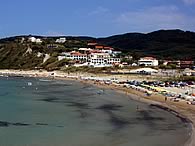
Gentle hills roll down to a 500 metre flat and deep sandy beach that is remains fairly quiet even in the high summer season.
Shallow water and gently sloping sands make San Stefanos a favourite for families and there are sunbeds on the beach which, at 70 metres deep, is big by Corfu standards.
Agios Stefanos resort has some watersports and a children’s play area. Tucked away from the main traffic routes and only approached along narrow lanes the resort tends to be quieter than most.
It has some good tavernas and small family hotels as well as the usual selection of shops and bars. Some outstanding scenery is on offer for hill walkers in this part of Corfu.
Arillas
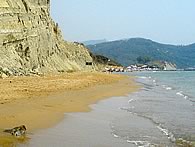
Beyond a rock outcrop at the northern end is an unofficial nudist beach where they get the best of the sand in a sheltered cove.
Walks along the headland from Agios Stefanos to the beach Arilas, or Arillas, are popular, with fine views and splendid sunsets.
The islet of Gravia just offshore and reachable for decent swimmers. Sunbeds, watersports, boats for hire and a water taxi to other resorts along the coast are all on offer.
The resort has a wide selection of mini-markets and a few shops selling souvenirs. Cafes and tavernas line the long promenade.
Agios Georgios (north)
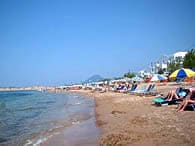
Many regard the long and gently sloping beach as one of the best in Corfu and it’s a popular destination for young families.
The beach very long at 1.4 kilometres and wide too at 140 metres with families sticking to the centre, naturists to the north and a few enjoying the narrow and less crowded south.
A river runs through the main resort where visitors will find the usual supermarkets, tavernas, bars and car hire. Mountain bikes can be hired; there is even a small bowling alley.
Afionas village, on the headland ,has views over the bay and the 13th century fortress of Angelkastro is a 30 minute car ride away.
Paleokastritsa beach
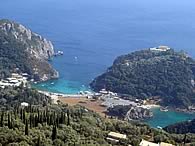
The resort is spread over three large bays and they are big enough to soak up the visitors. The main beach is a narrow horseshoe crescent of shingle backed by a large hotel and car park.
The water is deep but sunbeds and plentiful and showers and toilets are available. Boats leave regularly for trips to nearby caves, grottos and small beaches. The usual tourist watersports are also on offer including scuba diving.
The other two bays – a smaller but sandier one to the north and another sandy strip around the headland are serviced by boat taxis and take the overspill from the main beach.
Tavernas are notoriously expensive and are a few music bars on the edge of the resort. Overlooking the bay is a 13th century monastery, a favourite with coach parties.
The monastery has some impressive icons, a carved wooden ceiling and a bizarre sea monster. The paved gardens have remarkable sea views but there are even better views at nearby Lakones and the villages beyond.
Liapades
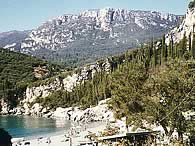
The beach at Liapades is mostly soft sand with a few stones and the waters are very shallow, ideal for children.
Large rocks either side of the bay add interest and there is parking close to the beach. Visitors report that wasps are a problem, no doubt nesting in the nearby pines.
The village is about a kilometre inland from the beach, but still worth a visit. It’s a typical Greek village of narrow streets and whitewashed homes and has some good tavernas.
Ermones
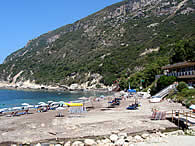
It is a steep descent to the beach and the Ermones Beach Hotel boasts a small funicular railway to ferry the guests down the almost vertical cliffs.
The beach is sand and shingle, clean but divided by the Ropa river that cuts its way to the shore here. The beach shelves gently, so it’s safe for children, and rocks invite exploration at either end.
Sunbeds, toilets and showers are available and there is parking above, although there are very steep steps to negotiate. Windsurfing and boat hire are on offer. The beach has three tavernas and three more above. After dark, the place thumps to the hotel discos but there is no other entertainment and for shopping there is just one mini-market.
OK if your choice is an all-inclusive package deal but otherwise there few good reasons to visit Ermones.
Myrtiotissa
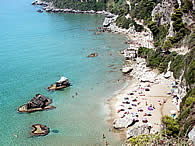
Relatively difficult to reach requiring a scramble down the cliff face from the village at Vatos, the narrow but pretty stretch of sand is pocked by mighty boulders and overlooked by scrub covered cliffs.
Once a well-kept secret, the beach is now regularly invaded by day-trip boats and gets seriously crowded in the high summer. But the beach still has great charm, despite the crowds, although it is best enjoyed at the end of the day when the boat trippers have left.
Mrytiotissa beach is still quiet enough to be a favourite haunt of nudists, but these have tailed off the beach has grown in popularity. The beach cantina is noted for excellent snacks.
Glyfada
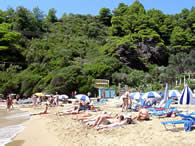
Glyfada is hugely popular, especially with Italians, and it can get very crowded in high season.
The Louis Grand Hotel which takes up a mammoth portion of the beach. The small car park that sits nearby can soon reach full capacity and finding a place to park can be a pain later in the day.
Although the waters are shallow at first they deepen sharply further out and the beach is notorious for strong currents at the northern end, with warning flags for swimmers.
Facilities like showers and toilets and a beach taverna are available along with all the watersports you expect on a big popular beach.
On the headland is a large rock formation that’s a popular spot for show-off diving displays by the young Italian bucks.
Pelekas
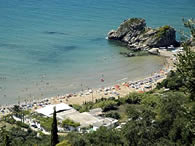
The beach, also called Kontogialos, lies below the village and it’s a 10 minute walk down the hill to a wide crescent of sand with sunbeds, showers and toilets.
There are four tavernas and a hotel behind the beach as well as boat rental and a variety of watersports on offer.
The fishing harbour to the south adds interest and the beach of Yaliskari, just around the headland, has amazing rock formations.
Pelekas village has an authentic Greek character and it is noted for its sunsets. Here sits the Kaiser’s Throne, a lookout tower on an outcrop of rock that was a favourite spot of Kaiser Willhelm II.
South coast beaches
The Corfu southerly beach resorts are found below a line that drawn from Kerkyra in the east to Pelekas in the west. The eastern side of the long peninsula was the first to attract package tourism and the results in many resorts were tacky, tawdry and tatty. The market has changed and Corfu locals now look to attract more upmarket clients. By way of contrast the western coast is both wild and uninhabited, yet still wildly popular, mostly among the Greeks themselves.
Agios Gordios
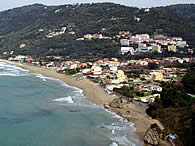
Empty coves can be found north and south and attract naturists. Some interesting beach rocks at the southern end with the Ortholithi, the trademark standing rock in the sea.
The main Agios Gordios beach can get quite busy and there are beach tavernas and watersports on offer. A single road leads inland lined with tavernas, shops and mini-markets. Parking can be a problem as the narrow road is a dead end at the beach with little room for turning a car.
Most nightlife is at the north end of the resort, although this only amounts to a few music bars.
The bus to Corfu Town runs five times a day in the summer season and is reliable enough for a day out.
The small, protected, sandy beach of Yaliskari lies to the north. Pine trees sweep down to the water and a couple of cantinas provide meals and drinks.
Paramona
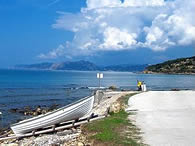
Paramona has developed as a small resort in recent years with holiday hotels, apartments and some beach tavernas. There is parking on the road and showers on the beach.
More remote beaches lie further south at Prasoudi and Skidi but require a 30 minute walk through olive groves to get to them.
Prasoudi has become popular, blessed with fine golden sand and a couple of beach cantinas noted for their seafood. Standing rocks offshore add interest with parking at the taverna, although it’s a steep scramble down to the sands. No buses go here.
Saint George beach
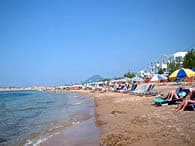
It’s nothing like Kavos, only 20 minutes away, and appeals more to the middle-aged than the muddle-brained.
The north end of the long sands is called Issos beach and it’s overseen by a large hotel complex. The south is known as Golden Beach which merges into a string of sandy stretches variously known as Maltas or Marathias and Santa Barbara.
Agios Georgios itself has plenty of popular tourist attractions – tavernas and bars, karaoke, wide screen TVs, beach sports, doughnut sellers, souvenir stands and day trips on offer from the local travel agents.
Paragliding and jet skis are popular at this long and straggling resort that has become a favourite of Brits.
A walk to the inland village Argirades will reward with astonishing views, some lovely cafes and a taste of traditional Corfu village life.
Kavos beach
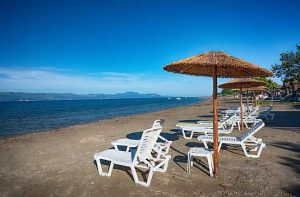
Desperately dire and unrivalled for ugliness, Kavos is a fit place for the mentally challenged 18-30 year olds that it attracts by the thousand. Gangs of youths looking for a “larf” give Kavos the hostile air of an English soccer town on match day.
Expect shops selling lewd T-shirts, video bars named after TV sitcoms and lager swilling bozos trying to match IQs against sandal sizes. Men usually outnumber women about 10-1 so boys are far more likely to get tanked up than chatted up.
The Kavos resort is a single busy street – no pavement – with scores of music bars (80 at the last count), dance clubs and karaoke cafes that go mental from 11.30pm to sunrise. Club and bar touts are the usual problem – some will forcibly drag you in.
Visitors complain that drinks are watered down and ‘free shots’ are mixed with meths to cut costs. Food in Kavos is almost exclusively pizzas, burgers, kebab and chips.
Thieving is common and walking at night is dangerous on the narrow road as half-wit boys outgun each other on quad bikes. It all makes for a very exciting atmosphere on the narrow Kavos drag as those youngsters spill out of the bars to dance in the street.
The beach at Kavos is notoriously is poor, covered in rotting seaweed, fag ends, beer cans and condoms. It’s often used as a nighttime toilet by drunken clubbers.
Boat trips are a way to escape Kavos – those to Parga, Paxos and Blue Lagoon are recommended. Don’t consider Kavos out-of-season – the place shuts like a clam when the kids leave.
Benitses
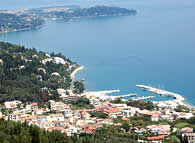
The resort at Benitses is about a kilometre long, strung along the east coast about 12km south of Corfu Town. The southern end still clings precariously to its ignominious past with a string of brash music bars and cheap tavernas.
But the Benitses old town has miraculously recovered some of its pre-60s charm and the houses today are fairly drowning in cascades of flowers as the locals try to shake off the tawdry past.
Most of the beach at Benitses is pebble and shingle with a very steep drop into the sea so its not great for families with children.
There are the usual sunbeds and plenty of watersports such as paragliding, water skiing and pedaloes as well as small sea jetties that are good for diving off.
Many tavernas at the harbour end of Benitses have improved so much in recent years that they are now even frequented by locals and Benitses can make a good choice for those seeking a good island base with lively nightlife and plenty of late-night bars.
